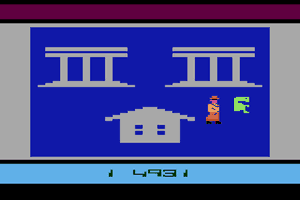| |
The worldwide video game console crash of 1983 was caused by a combination of factors, though with different factors in several markets:
In Europe, the boom years of personal computing (1981–1985) were trumpeted by very aggressive marketing of inexpensive home computers, especially the Commodore 64, with the theme “Why buy your child a video game and distract them from school when you can buy them a home computer that will prepare them for college?”[1] Marketing research for both sides tracked the change as millions of consumers shifted their intention to buy choices from game consoles to low-end computers that retailed for similar prices. At the same time, a strong culture of playing and writing video games for these personal computers arose in Europe, making the European crash more of a platform shift than a total collapse of the industry.
A similar marketing campaign occurred in the U.S. without the same effect, where instead the personal computer industry grew because of the crash and is not seen as directly causing it.
A flood of consoles on the market giving consumers too many choices. At the time of the U.S. crash, there was a plethora of consoles on the market: Atari 2600, Atari 5200, Bally Astrocade, Colecovision, Coleco Gemini, Emerson Arcadia 2001, Fairchild Channel F System II, Magnavox Odyssey2, Mattel Intellivision (and its just released update with slew of peripherals, Intellivision II), Sears Tele-Games systems (which included 2600 and Intellivision clones), Tandyvision, and Vectrex. Each one of these had their own library of games, and many had (in some cases large) 3rd party libraries. Likewise, many of these same companies announced yet another generation of consoles for 1984, such as the Odyssey3, and Atari 7800.
A flood of poor titles from hastily financed startups, combined with weak high-profile Atari 2600 games based on the hit movie E.T. and the red-hot arcade game Pac-Man.
The news media sensationalized both the boom days of 1980 and the problems of 1982–83. In particular, the story of Atari burying thousands of E.T. cartridges in a New Mexico landfill[3] shifted the outlook of the video game market in the eyes of many media outlets.
Up until the early 1980s, personal computers had primarily been sold in specialty computer stores at a cost of more than $1,000 USD, which is over $2,500 in 2006 American dollars. The early 1980s saw the introduction of inexpensive computers that could connect to a TV set, and offered color graphics and sound. The first of these systems were the Atari 400 and 800, but many competing models vied for consumer attention. As the pioneering computer-book author and journalist David H. Ahl recounted in 1984:
In the spring of 1982, the TI 99/4A was priced at $349, 16K Atari 400 at $349, and Radio Shack Color Computer at $379, while Commodore had just reduced the price of the VIC-20 to $199 and the C64 to $499.
Since these and other computers generally had more memory available—and better graphic and sound capabilities—than a console, they permitted more sophisticated games and could also be used for tasks such as word processing and home accounting. Also, their games were sometimes much easier to copy, since they came on floppy disks or cassette tapes instead of ROM modules (though many of them continued to use ROM modules extensively, or even primarily, as well).
Commodore explicitly targeted video game consoles in its advertising, offered trade-ins toward the purchase of a Commodore 64, and suggested that college-bound children would need to own computers, not video games. Research by Atari and Mattel confirmed that these television ads badly damaged both their machines' images and sales.
Unlike most other computer manufacturers, Commodore also sold the machines in the same outlets as video game consoles: discount, department and toy stores. Commodore's vertical integration allowed it to engage in aggressive discount pricing; its margins were much higher than those of Texas Instruments, Coleco, or Atari, as Commodore's MOS Technology, Inc. subsidiary actually manufactured many of its own chips (notably the 6502 CPU). Some companies had to get their chips from this subsidiary, leading to a similar situation that had occurred in the calculator market in the early 1970s, when companies found themselves buying chips from Texas Instruments but also having to compete with TI's calculators. Other companies, such as Atari (who used the 6502 in Atari computers and video game consoles), were able to set up deals to allow manufacturing with their own third party companies.
The first chapter of the coming disaster was written with games with perceived high quality: Activision was co-founded by Atari programmers David Crane, Larry Kaplan, Alan Miller and Bob Whitehead, who left the company in 1979 because Atari did not allow credits to appear on the games and did not pay employees a royalty based on sales. At the time, Atari was owned by Warner Communications. The developers felt that they should receive the same recognition that musicians, directors, and actors get from Warner's other divisions.
Atari quickly sued to block sales of Activision's products, but never won a restraining order and ultimately lost the case in 1982.
This court case legitimized third-party development, and companies as ill-prepared as Quaker Oats (as division US Games) rushed to open video game divisions, hoping to impress both Wall Street and consumers. Companies lured away each others' programmers or used reverse engineering to learn how to make games for proprietary systems. Atari hired several Intellivision programmers, prompting a lawsuit by Mattel against Atari that included charges of industrial espionage.
Despite the lessons learned by Atari in the loss of Crane, Kaplan, Miller and Whitehead to Activision, Mattel continued to try to avoid crediting game designers. Rather than reveal the names of Intellivision game designers Gabriel Baum, Don Daglow, Rick Levine, Mike Minkoff, John Sohl and others, Mattel instead required that a 1981 TV Guide interview with them was to change their names to protect their collective identities. Colecovision designers like Paul Jaquys worked in similar obscurity, feeding more departures to upstart competitors.
Unlike Microsoft, Nintendo, or Sony in later decades, the hardware manufacturers had lost the exclusive control of their platform's supply of games. With it they had lost the ability to make sure that the toy stores were never overloaded with products. Activision, Atari and Mattel had experienced programmers, but many of the new companies rushing to join the market did not have experienced talent to create the games. Titles such as Chase the Chuck Wagon, Skeet Shoot, and Lost Luggage were examples of games companies made in the hopes of taking advantage of the video game boom. While heavily advertised and marketed, the games were perceived to be of poor quality and did not catch on as hoped.
The established video game companies also played a role in the crash. For example, when Atari issued its widely advertised E.T. game, it manufactured millions of units in anticipation of a major hit. Unfortunately, the game had been rushed to market after only six weeks of development time. The game's poor reputation spread quickly by word of mouth, and the story was picked up by newscasts that trumpeted E.T. as the first great bomb of the video game age. |
|


